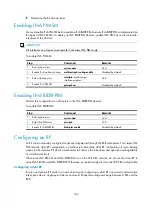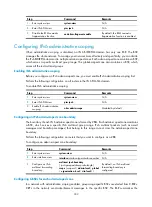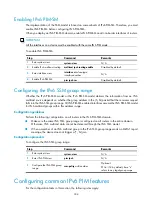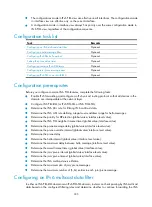
321
Step Command
Remarks
1.
Enter system view.
system-view
N/A
2.
Enter IPv6 PIM view.
pim ipv6
N/A
3.
Configure the BS period.
c-bsr interval
interval
Optional.
By default, the BS period is
determined by the formula "BS
period = (BS timeout timer – 10) /
2." The default BS timeout timer is
130 seconds, so the default BS
period is (130 – 10) / 2 = 60
(seconds).
The BS period value must be
smaller than the BS timeout timer.
4.
Configure the BS timeout
timer.
c-bsr holdtime
interval
Optional.
By default, the BS timeout timer is
determined by the formula "BS
timeout timer = BS period × 2 +
10." The default BS period is 60
seconds, so the default BS timeout
timer is 60 × 2 + 10 = 130
(seconds).
NOTE:
If yon configure the BS period or the BS timeout timer, the system uses the configured one instead of the
default one.
Disabling BSM semantic fragmentation
Generally, a BSR periodically distributes the RP-set information in bootstrap messages within the IPv6
PIM-SM domain. It encapsulates a BSM in an IPv6 datagram and might split the datagram into fragments
if the message exceeds the MTU. In respect of such IP fragmentation, loss of a single IP fragment leads
to unavailability of the entire message.
Semantic fragmentation of BSMs can solve this issue. When a BSM exceeds the MTU, it is split to multiple
BSMFs.
•
After receiving a BSMF that contains the RP-set information of one group range, a non-BSR router
updates corresponding RP-set information directly.
•
If the RP-set information of one group range is carried in multiple BSMFs, a non-BSR router updates
corresponding RP-set information after receiving all these BSMFs.
Because the RP-set information contained in each segment is different, loss of some IP fragments will not
result in dropping of the entire message.
Generally, a BSR performs BSM semantic fragmentation according to the MTU of its BSR interface.
However, the semantic fragmentation of BSMs originated due to learning of a new IPv6 PIM neighbor is
performed according to the MTU of the outgoing interface.
The function of BSM semantic fragmentation is enabled by default. A device that does not support this
function might regard a fragment as an entire message and learns only part of the RP-set information.
Therefore, if such devices exist in the IPv6 PIM-SM domain, you need to disable the semantic
fragmentation function on the C-BSRs.






























